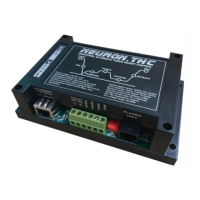USER MANUAL
quicker, typically 5-10%. For higher speeds on thinner or warped metal where normal cutting
voltage changes more rapidly, use a higher number around 10-15% or even 20%.
Kerf Detect
Description: if the plasma torch passes over a void while cutting, arc voltage rapidly rises and the
THC responds by violent downward motion which can smash the torch into the material possibly
damaging it. This is a situation that is difficult to detect and handle. To a certain extent it can be
mitigated by good nesting techniques but can still occur on thicker material when a slug falls
away. One suggested technique is to monitor the rate of change in torch volts over time (dv/dt)
because this parameter is orders of magnitude higher when crossing a void than what occurs due
to normal warpage of the material.
Controller compare the moving average with the dv/dt and halt AVC operation once the dv/dt
exceeds the normal range (Kerf Detect Level) expected due to warpage.
Setting: OFF / ON
Kerf Detect Level
Description: This parameter sets the sensitivity of the Auto Kerf Detection level on a relative
scale. A value of 1 is the most sensitive and will activate at lower voltage increases, 15 is the
least sensitive and will activate at higher voltage increases.
Setting: 1 – 15, default value is 12.
Start IHS Height
Description: This is the height above the last known workpiece position that the THC switches
from Automatic speed to the slower IHS speed. This height should be set high enough to avoid
contacting the workpiece.
Setting: 2.54 – 50.8 mm (0.1 – 2.0 in)
Skip IHS Within
Description: If the next starting point is within this distance of the end of the previous cut, the
THC skips the IHS. When this happens, the torch goes directly to the Transfer
Height and skips contact with the workpiece. This setting can improve the overall
machine production rate but should not have any effect on the part being cut. Clear the checkbox
to disable this feature.
Setting: 0 – 3000 mm
Transfer Height
Description: This value determines the height above the workpiece where the torch is initially
fired. It is the torch height after an IHS and is entered as a percentage of the Cut Height.
This setting can be used to improve the ability of the torch to transfer to the workpiece
for processes that use a very high Pierce Height or have difficulty in transferring.
Setting: 50% – 400% of Cut Height, commonly 150%
Retry on transfer fail
Description: This value determines the number of times that the controller will attempt to re-start
the plasma after failing to transfer. The controller removes and reapplies the start signal on each
re-start attempt.
Setting: 0 – 10
Transfer time
Description: This is the number of seconds that the controller will wait for transfer before
attempting a retry.
Setting: 0 – 10 seconds
Jump Height
Description: This value determines the height above the workpiece that the torch is raised to
clear the top dross puddle that can form during the pierce. It is the torch height after Pierce. This

